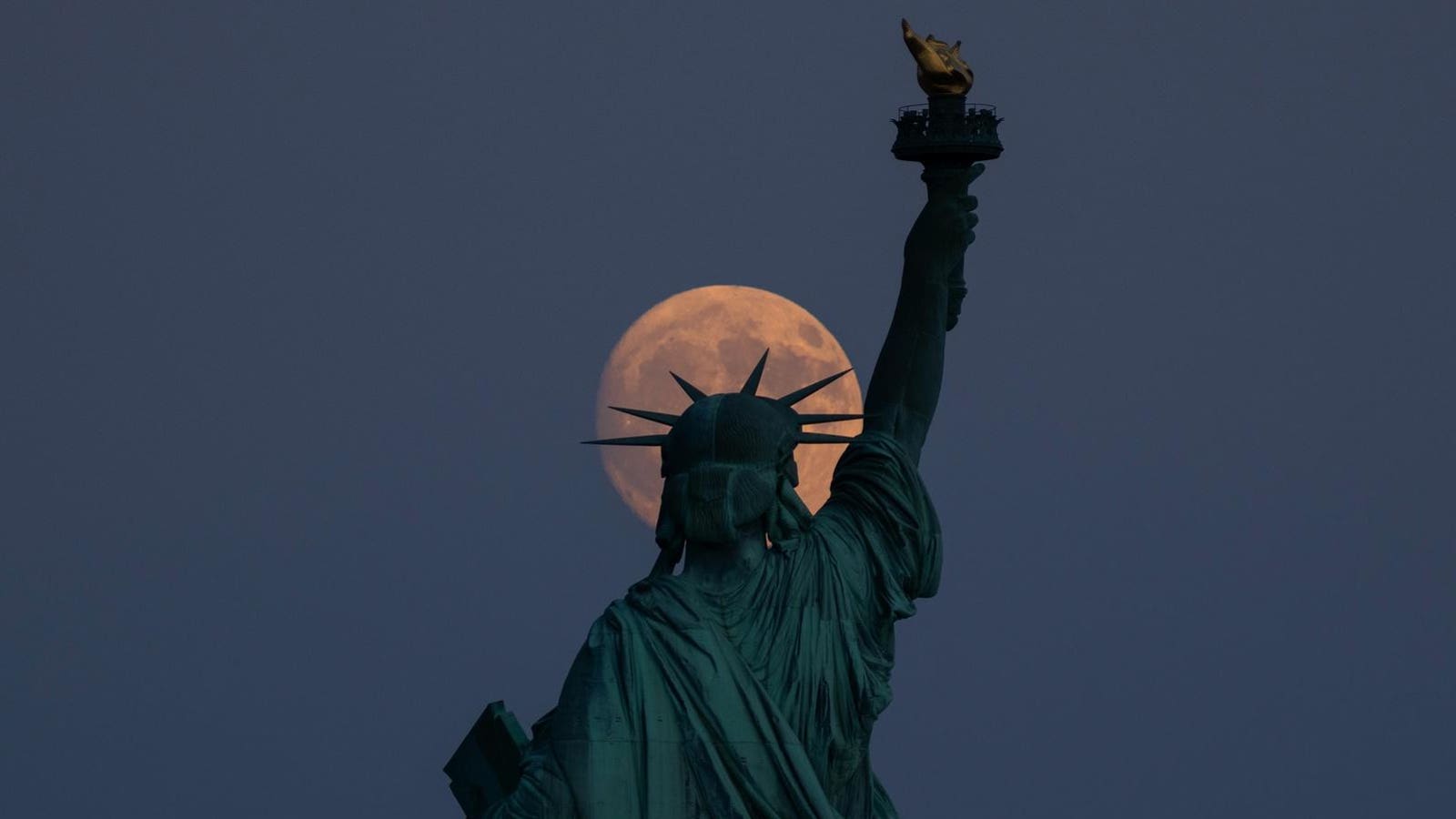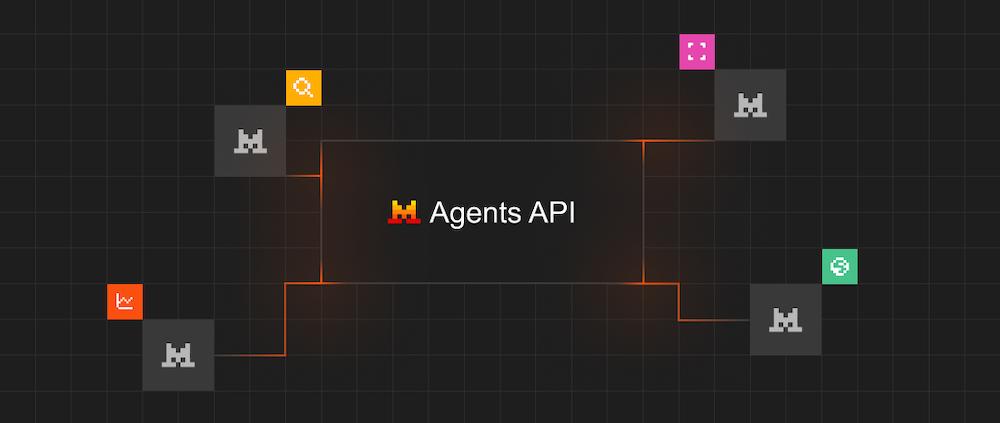Topline
The second full moon of summer in the Northern Hemisphere — the sturgeon moon — performed a rare trick of rising into twilight skies twice in successive nights this weekend. It appeared in the southeast just as Saturn was rising alongside it in the east, and traced a low arc across the southern sky as seen from the Northern Hemisphere. Here are all the best photos from around the world.
A 98 percent illuminated waxing gibbous moon rises behind the Statue of Liberty, a day before the full Sturgeon Moon in New York City on August 7, 2025, as seen from Jersey City, New Jersey. (Photo by Gary Hershorn/Getty Images)
Getty Images
Key Facts
On Friday, Aug. 8, the full sturgeon moon appeared on the southeast horizon during dusk, just minutes after sunset, glowing a pale orange in the gathering dusk.
It turned 100% full at 3:56 a.m. EDT on Saturday, Aug. 9, and was seen once again appearing on the horizon just after sunset, this time a little brighter orange.
As seen from mid-northern latitudes, the sturgeon moon was seen rising in the southeast, tracing a low arc across the southern sky, and setting in the southwest around sunrise. On both nights, the full moon appeared just as Saturn was rising due east.
It’s relatively rare for a full moon to rise on successive nights just 30 minutes or so apart, as happened on Friday and Saturday. Although the moon rises, on average, 50 minutes later each night, when the angle of its orbital path is shallow — as it is right now, as seen from mid-latitudes of the Northern Hemisphere — the moon rises only slightly later each night.
The full moon is seen rising behind the Libeskind tower (L) designed by Polish-born US architect Daniel Libeskind and and Isozaki tower designed by Japanese architect Arata Isozaki at the Citylife district in Milan, on August 8, 2025. (Photo by Stefano RELLANDINI / AFP) (Photo by STEFANO RELLANDINI/AFP via Getty Images)
AFP via Getty Images
Why August’s Full Moon Is The Sturgeon Moon
According to Farmer’s Almanac, August’s moon gets its odd name from the abundant freshwater fishing in parts of North America in August, particularly of lake sturgeon in late summer. Other names — which make more sense to parts of the country and the world that don’t have sturgeon fish — include harvest moon, moon of the ripening, grain moon, green corn moon, black cherries moon and plum moon.
Sturgeon full moon rising behind Rocca Calascio castle is seen in Rocca Calascio, Italy, on August 8th, 2025. The Full Sturgeon Moon is a traditional name given to the full moon in August by Native American tribes because sturgeon fishes were most readily caught during this month in the Great Lakes of North America (Photo by Lorenzo Di Cola/NurPhoto via Getty Images)
NurPhoto via Getty Images
Why The Sturgeon Moon Looked Orange
When the full moon is highest in the sky, it’s such a bright, white color that it’s difficult to look at. Only when it’s relatively low down is it comfortable to view. When it’s close to the horizon — at moonrise and moonset — it glows orange. That’s because, as when viewing a sunset or a sunrise, your eyes are receiving light that has been filtered by Earth’s atmosphere, which is thickest close to the horizon. It filters out short-wavelength blue light and more easily allows longer-wavelength reddish light through.
People looking at full moon rising are seen in Rocca Calascio, Italy, on August 8th, 2025. The Full Sturgeon Moon is a traditional name given to the full moon in August by Native American tribes because sturgeon fishes were most readily caught during this month in the Great Lakes of North America (Photo by Lorenzo Di Cola/NurPhoto via Getty Images)
NurPhoto via Getty Images
Sturgeon Moon And The Perseid Meteor Shower
Although the rise and set of the Sturgeon Moon was dramatic, it comes at a cost this month. One of the most prolific meteor showers of the year, the Perseids, peaks overnight on Aug. 12-13, when about 75 “shooting stars” can be seen each hour. However, the presence of a still bright waning full moon will make the faintest meteors impossible to see.
Sturgeon full moon rising behind Santa Maria della Pietà Church is seen in Rocca Calascio, Italy, on August 8th, 2025. The Full Sturgeon Moon is a traditional name given to the full moon in August by Native American tribes because sturgeon fishes were most readily caught during this month in the Great Lakes of North America (Photo by Lorenzo Di Cola/NurPhoto via Getty Images)
NurPhoto via Getty Images
Skywatchers Prepare For Saturn’s Opposition
Next month, on Sept. 21, Saturn will be at opposition. All this means is that Earth — which orbits the sun a lot faster than Saturn — will be between Saturn and the sun. Consequently, Saturn will appear to rise at sunset and set at sunrise and be 100% illuminated from Earth’s point of view. It will also be at its biggest and brightest of the year.
The Sturgeon Moon rises through clouds over 42nd Street in New York City on August 8, 2025, as seen from Weehawken, New Jersey. (Photo by Gary Hershorn/Getty Images)
Getty Images
When Is The Next Full Moon?
The September 2025 full moon is the corn moon, which will turn full on Sunday, Sept. 8. From Asia, Australia and the Pacific Ocean, it will be a total lunar eclipse, during which the moon will turn a reddish color for 82 minutes. It will be similar to that seen in North America on March 13-14, but September’s total lunar eclipse will not be visible from North America.








